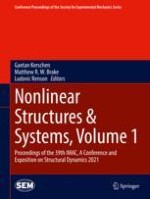2022 | Buch
Nonlinear Structures & Systems, Volume 1
Proceedings of the 39th IMAC, A Conference and Exposition on Structural Dynamics 2021
herausgegeben von: Prof. Gaetan Kerschen, Dr. Matthew R.W. Brake, Dr. Ludovic Renson
Verlag: Springer International Publishing
Buchreihe : Conference Proceedings of the Society for Experimental Mechanics Series
